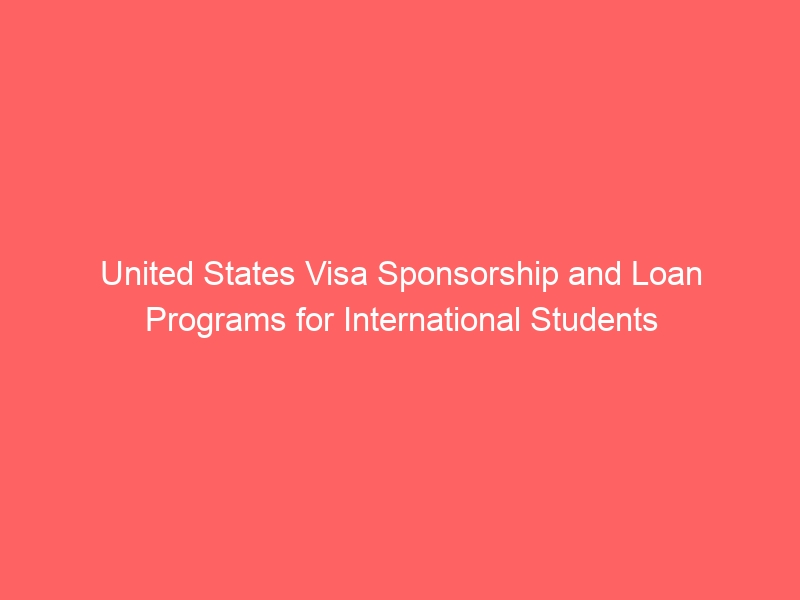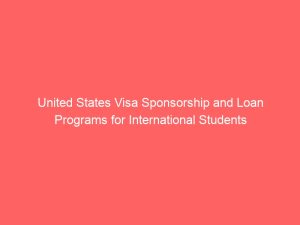The United States has long been a top destination for international students seeking quality education, advanced research opportunities, and exposure to a multicultural environment. However, studying in the U.S. can be expensive, and for many students, the costs go beyond tuition to include accommodation, health insurance, transportation, and daily living expenses. To address these financial challenges, many students explore loan programs. At the same time, some students benefit from visa sponsorships provided by institutions or organizations that help secure legal entry and stay in the country. Understanding how visa sponsorship and loan programs work together can help international students successfully fund their studies in the U.S. without unnecessary stress.
Understanding Visa Sponsorship for International Students
Visa sponsorship for students refers to the process where a school, college, university, or organization officially supports a student’s application to enter the U.S. for educational purposes. For most students, this involves receiving an official document (like the Form I-20) from the institution, which is required to apply for the F-1 or M-1 student visa.
While most student visas are non-immigrant and tied to enrollment in a specific program, some institutions and scholarship bodies extend additional support, including financial aid or work-study sponsorships, to ease the burden of living and studying in the United States.
Types of Visas Relevant to International Students
International students primarily enter the U.S. under specific visa categories:
F-1 Visa
The most common visa for academic students, the F-1 visa allows individuals to study at accredited U.S. colleges, universities, and high schools. It also permits limited on-campus work and optional practical training (OPT) after graduation.
M-1 Visa
The M-1 visa is for students enrolled in vocational or non-academic programs. It has stricter work limitations compared to the F-1 visa.
J-1 Visa
This visa is for exchange visitors participating in approved programs, including high school exchanges, research scholars, and professional training. J-1 students may receive sponsorship through organizations, cultural exchange programs, or government initiatives.
The Role of Visa Sponsorship in Securing Loans
Visa sponsorship increases credibility when applying for loans. Lenders prefer borrowers with documented legal status and a clear purpose for their stay in the country. When a recognized U.S. institution sponsors your visa, it assures lenders that you are legitimately enrolled and have a structured plan for your time in the United States.
Types of Loan Programs Available for International Students
International students face unique challenges in accessing loans due to the lack of a U.S. credit history. However, several loan programs cater to this group:
International Student Loans
These are specialized loans for non-U.S. citizens studying in the country. Many of these loans require a U.S.-based co-signer with good credit, although some lenders have started offering loans without this requirement.
Federal Loans
Generally, U.S. federal student loans are not available to international students unless they are eligible non-citizens. However, certain visa categories or residency statuses may open access to limited federal aid.
Private Loans
Private lenders offer loans to international students, often in partnership with universities. Interest rates vary, and repayment terms depend on the student’s future earning potential and co-signer status.
Institutional Loans
Some universities have in-house loan programs for international students, funded through endowments or partnerships with financial organizations. These loans sometimes come with lower interest rates and flexible repayment schedules.
How to Qualify for an International Student Loan
Qualifying for a loan as an international student requires careful preparation:
- Visa Sponsorship Confirmation – Ensure your institution provides the official documentation proving your legal student status.
- Enrollment Proof – Lenders will require proof of admission and active enrollment in an accredited U.S. institution.
- Co-Signer Arrangements – If needed, secure a co-signer who is a U.S. citizen or permanent resident with a strong credit score.
- Financial Documentation – Show bank statements, sponsorship letters, and any existing scholarships to strengthen your application.
- Creditworthiness – While you may not have a U.S. credit score, some lenders consider international credit histories or academic performance.
Combining Visa Sponsorship with Loan Benefits
When visa sponsorship and loan programs work hand in hand, students can enjoy multiple benefits:
- Smooth Immigration Process – Sponsorship simplifies your visa application process.
- Easier Loan Approvals – Having sponsorship demonstrates legitimacy and stability.
- Financial Coverage – Loans ensure you can cover both tuition and living expenses without constant financial stress.
- Better Academic Focus – Financial security allows students to concentrate on their studies rather than juggling multiple jobs.
Step-by-Step Process to Secure Visa Sponsorship and Loans
Step 1: Choose an Institution That Sponsors Student Visas
Look for universities and colleges with established processes for supporting international students. Ensure they are accredited and authorized to issue the I-20 or DS-2019 forms.
Step 2: Receive Your Admission Letter and Visa Documents
Once accepted, your institution will provide the necessary forms for your visa application. Review the sponsorship terms carefully.
Step 3: Apply for the Student Visa
Submit your visa application to the U.S. embassy or consulate in your home country. Prepare for the interview by understanding your program details and financial plans.
Step 4: Research Loan Options Early
Identify potential lenders before arriving in the U.S. Compare interest rates, repayment schedules, and co-signer requirements.
Step 5: Gather Loan Application Documents
Include your visa sponsorship letter, admission proof, passport, and any supporting financial evidence.
Step 6: Submit Applications
Apply for multiple loan programs to increase approval chances, especially if one lender has stricter requirements.
Step 7: Manage Funds Responsibly
Use the loan to cover essential expenses like tuition, housing, and transportation. Avoid unnecessary debt.
Common Mistakes to Avoid
International students sometimes make errors that can cost them opportunities:
- Waiting Too Long to Apply – Delaying loan applications may lead to missing tuition payment deadlines.
- Ignoring Interest Rates – Focusing only on approval without checking rates can lead to expensive repayments.
- Not Understanding Sponsorship Terms – Misinterpreting visa restrictions can cause legal or academic issues.
- Over-Borrowing – Taking more money than needed can lead to long-term debt challenges.
Building a Financial Future After Graduation
Many international students hope to stay in the U.S. after graduation through Optional Practical Training (OPT) or employer-sponsored work visas like the H-1B. Building good financial habits during your studies can make future loan applications and credit opportunities much easier. Always make payments on time, keep your credit utilization low, and maintain a good relationship with your bank or lender.
Conclusion
United States visa sponsorship and loan programs for international students are essential tools for making higher education in the U.S. accessible to students from around the world. Visa sponsorship provides the legal right to study, while loans offer the financial support needed to succeed. By understanding the application process, eligibility criteria, and best practices for managing these opportunities, international students can focus on achieving their academic and career goals without being weighed down by financial uncertainty.




